Nov 14, 2025
Nov 14, 2025
As a member of a new internet group of Indian Dancers in California, I noticed an interest among dance teachers to discuss the practice of Arangetram and the paradoxical concerns that this practice raises. This prompted me to revisit a paper that I presented along with my colleague M.A. Greenstein, 4 years ago at the Society of Dance History Scholars Conference in Oregon. The following is based on that paper. I submit it to provoke the thought of your readers with the caveat that this is my opinion and mine alone based simply on my observations and experiences. It is not meant to condemn or criticize the practice of this tradition, either in its pure or degenerate form, or the practitioners who believe in it. I hope it will make you both laugh and think.
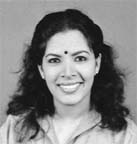
In service to dance
Ramaa Bharadvaj
Director: Angahara Ensemble, California, U.S.A.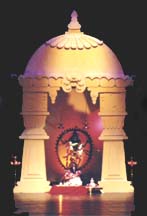 Transmission through Translation
Transmission through Translation
The Contemporary Arangetram
Arangetram is a Tamil language word, which means the etram or ascending of the arangu or performance stage by a dancer, on the completion of her training. We find the mention of this practice in third century classicSilappadikaram, by Prince Ilango Adigal. In his third chapter,Arangetrukaadai or the chapter of ascending the stage, the poet vividly describes the graduation concert of the twelve- year old dancer Madhavi.
Paraphrased, he writes,
After studying dance full time for seven years, Madhavi prepares to present herself before the king. The special stage is adorned with embroidered curtains, strings of pearls and other ornaments, and is lit by a single large oil lamp placed in front. The sacred bamboo rod is bathed in holy water from a golden vessel and wreathed in garlands of fragrant flowers. It is ceremoniously brought into the theater to take its place of honor on stage. Accompanied by harp, flute, oboe, drums and cymbals, Madhavi enters and begins an invocation dance. She performs the dances of the northern and southern traditions in various rhythm patterns with such beauty and mastery, that the king awards her with a wreath of green leaves, 1008 gold coins, and the title of talaikol or lead dancer.
When you live in Southern California, (or I suppose anywhere in the U.S) you get used to the idea that the Arangetram is no ordinary display of the Bharata Natyam tradition. Its practice gives rise to paradoxical concerns, when the dance tradition and its package deal debut become points around which Indian families rally to guarantee the continuity of Indian values, to reconfirm their Indianness to themselves and to their community, and accordingly prepare their daughters to enter middle-class Indian-American life.
Case in example!
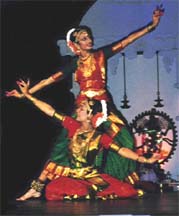 The Arangetram of my students - Anjali Desai and Payal Hathi 4 years ago! When Anjali and Payal prepared to present themselves, after six years of part time training, the scenario was not very different from Madhavi's evening. The families had planned for this day for over a year. The girls had completed the study of the basic nine dances. To me, the Arangetram was going to serve the purpose of a final term paper - it would help them focus, practice and master these nine dances. The one-hour a week training session was extended to four hours. But looking at it from the parents point of view it seemed as if this was the Lifetime Achievement Award at the Oscars. The theater was carefully selected to accommodate what seemed like the entire Gujarati population of Los Angeles. The invitations and programs would be printed in India in full color. The guest list was drawn, the menu planned. The ornately decorated performing stage (complete with hand carved pillars), the musicians, and the guest of honor were all there and more. The girls, the musicians and I, were even treated to a stretch limousine ride to the theater and the show began.
The Arangetram of my students - Anjali Desai and Payal Hathi 4 years ago! When Anjali and Payal prepared to present themselves, after six years of part time training, the scenario was not very different from Madhavi's evening. The families had planned for this day for over a year. The girls had completed the study of the basic nine dances. To me, the Arangetram was going to serve the purpose of a final term paper - it would help them focus, practice and master these nine dances. The one-hour a week training session was extended to four hours. But looking at it from the parents point of view it seemed as if this was the Lifetime Achievement Award at the Oscars. The theater was carefully selected to accommodate what seemed like the entire Gujarati population of Los Angeles. The invitations and programs would be printed in India in full color. The guest list was drawn, the menu planned. The ornately decorated performing stage (complete with hand carved pillars), the musicians, and the guest of honor were all there and more. The girls, the musicians and I, were even treated to a stretch limousine ride to the theater and the show began.
It was witnessed by 760 people - a kaleidoscopic sea of women and men, dressed to kill. A scrumptious meal consisting of India catered and home-made foods was served to everyone, picnic style. The cost of the entire event $20,000! I should add here that I refused to accept any payment for myself.
After the accolades, the standing ovation, the bouquets of flowers and the gifts, when the evening ends there is still a glaring difference between Madhavi's Arangetram and the simulated ones. While the former was equivalent to a doctoral dissertation, all simulated Arangetrams can be equaled only to a high school graduation. Does the grandeur of the event reflect the grandeur of the knowledge attained? The answer is an emphatic NO!
In early India, the ritual was presented to acknowledge the expertise gained by theSadir dancer who had dedicated herself to seven years of full time study and training of not just the technique of dance, but such related fields as music, poetry and languages. What did the dancer do after this training and graduation? Well, believe it or not, in the ancient Indian society, being a dancer was actually a legitimate occupation. At one time, the Brahadeeswara temple in the town of Thanjavur in South India is said to have employed as many as 400 dancing girls.
The role of the Arangetram has changed from the ancient times, because the role of the dance and the place of the dancer in society have drastically changed. Can students study Indian dance with a career objective, with assurances of economic stability (without having to resort to waiting at tables or part time jobs)? Where are the opportunities for a solo dancer (unless you are rich enough to present yourself or as I see happening in India to buy performances)? Where is the incentive to develop a career in dance, which requires study, training, more study and more training? Under these conditions, Arangetrams no longer celebrate the beginning of a new career; rather, they become the goal towards which the students work.
In her book "Temple to Theater", Anne Marie Gaston defined Arangetram as the culmination of the training phase of Bharata Natyam dancers. However, to many of the families, whose children attend Bharata Natyam classes in this country, the purpose of the ritual, and even the meaning of the word is a mystery. This has unfortunately led to the redefinition of the Arangetram as being 'the termination of the learning phase,' a learning phase that was part time to begin with." In many cases, the learning process stops right there because they have finished their Once in a Lifetime Performance; because the parents and the students are financially and physically exhausted. The simulated Arangetram gives the student a false sense of expertise and knowledge.
One day an Indian lady walked up to me and proudly introduced her lineage to me because I was a famous dancer in the community. You know she said, "my sister has finished her Arangetram and everything." I scratched my chin, leaned forward and asked, "I understand the Arangetram part, but what is that everything that you are talking about?" In my observation, an Arangetram is something to do before the kids go off to college - a big expensive party! And the audience members are mostly friends and colleagues, who know it would be rude not to accept the invitation. Yes, we do have a city full of dance chefs, but few know how to boil an egg!!
Dance in a Doggie Bag
Along with the transplantation of dance and its related cultural activities in cultures across the oceans in immigrant communities has risen a different problem; the commercialization of the dance form. Over enthusiastic immigrant parents, pick dance as an easy vehicle for giving their children a glimpse of the heritage. The job description of an Indian dance teacher in the U.S. reads like the job description of Cinderella's Fairy Godmother who turned the pumpkin into a chariot and tatters into a ball-gown. We are often expected to teach dance, religion, mythology, epics, folklore, history, culture, customs, traditions, language..... and music. Of course, we all know what happened to Cinderella's chariot at midnight!
Peer pressure and the need to keep up with the Joneses take priority over sanctity of the dance form. Teachers dangle carrots of Arangetram in two years, and in one Southern California case, a GIANT carrot of Arangetram in six months. Arangetram becomes the criterion to choose a teacher and Arangetram becomes the focal point around which the learning is centered. This leads to additional victimization by dance musicians. A percussion player once demanded that for an Arangetram, he be paid three times his normal rate. I asked him, "Will you play your drum with six hands instead of two?"
While my Kathak and Odissi teacher-friends denounce the practice calling it a concept belonging to the Bharata Natyam tradition, we suddenly notice that the trend is spreading infectiously from the field of dance to the field of music, and our social calendars filled with Music Arangetrams galore; something I had never heard of or seen while growing up in India.
And yet this Arangetram-to-go does seem to have some positive social value. It is in a way an effort on the part of the parents to reconcile their psychological identification with familial origins and their current place and values living in non-Indian communities. This effort, let us call it nostalgic nationalism or unconscious classicism, is a curious instance of cultural translation, whereby families regard Bharata Natyam as a significant way to introduce their daughters (and in rare cases, sons) to their heritage. And then there is also a need for the parents to reward themselves by means of community well wishing for devoting six or more years by financially, psychologically, and physically supporting their children's practice. In many cases, the mothers also fulfill their unlived dreams of dancing on stage.
My husband Bala put an added a class spin on the commentary, when he once told a friend of mine that a qualified girl in the ancient sense was someone who could sing, dance and trained in knowledge of the Vedas, in other words, proper preparation for marriage and raising off spring. Today, in place of academic training, dance is the primary means by which young Indian-American girls gain access to spiritual knowledge and are domesticated into patriarchal Indian society.
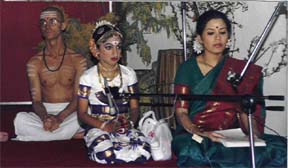 When my daughter Swetha had her arangetram at the age of 7, I chose the auspicious Sivaratri night. The Siva Temple in Concord California became the venue and the devotees who attended the puja were her audience. Of course, I also knew in my mind that this was a formality to satisfy my own need of offering and that Swetha's dance career was just beginning. So when parents approach me with their desire for a large scale spectacle, I always ask them, "Do you have money to burn?" They defend their choice, claiming that bigger production gratified thedesire to celebrate in an extended family manner, the achievement of their children. Therefore, after explaining my view point vehemently, I find that I have to give them the freedom of choice to do or not to do, in the most democratic manner possible.
When my daughter Swetha had her arangetram at the age of 7, I chose the auspicious Sivaratri night. The Siva Temple in Concord California became the venue and the devotees who attended the puja were her audience. Of course, I also knew in my mind that this was a formality to satisfy my own need of offering and that Swetha's dance career was just beginning. So when parents approach me with their desire for a large scale spectacle, I always ask them, "Do you have money to burn?" They defend their choice, claiming that bigger production gratified thedesire to celebrate in an extended family manner, the achievement of their children. Therefore, after explaining my view point vehemently, I find that I have to give them the freedom of choice to do or not to do, in the most democratic manner possible.
Conclusion:
Rethinking the Spectacular Society
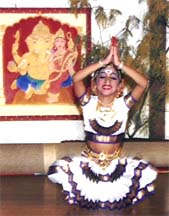 The translated spectacle of Arangetram, defines the anxieties and joys of the migrfamily which finds itself shuffling between the end of one cultural history, that is, of the Indian living in India and the beginning of another, the Indian residing in the U.S. Fed through the social sieve of the migr experience, the Arangetram takes on a spectacular and sometimes, degenerate form of tradition, presenting a mere image than a vivid embodiment of artistic values. Here I quote my friend M.A. Greenstein who writes quite brilliantly on the subject.
The translated spectacle of Arangetram, defines the anxieties and joys of the migrfamily which finds itself shuffling between the end of one cultural history, that is, of the Indian living in India and the beginning of another, the Indian residing in the U.S. Fed through the social sieve of the migr experience, the Arangetram takes on a spectacular and sometimes, degenerate form of tradition, presenting a mere image than a vivid embodiment of artistic values. Here I quote my friend M.A. Greenstein who writes quite brilliantly on the subject.
She writes: "I turn to the writings of French Situationalist artist Guy Debord and American art critic Hal Foster who each speak directly to end of cultural history products determined by what Debord calls as a society of spectacle. Debord states: "The end of cultural history manifests itself on two opposite sides: the project of its supercession in total history, and the organization of its preservation as a dead object in spectacular contemplation. One of these movements has linked its fate to social critique, the other to the defense of class power." Retooling his thoughts for our purposes, one could say that for an evening, the spectacle of the Arangetram defines a public moment of bourgeois migridentity. Hal Foster looks closely at the social function of spectacle from a Freudian point of view: "[U]nlike a typical representation which works via our faith in its realism, spectacle operates via our fascination with the hyper-real, with perfect images that make us whole at the price of delusion, of submission. We become locked in this logic because spectacle both effects the loss of the real and provides us with the fetishistic images necessary to deny or assuage this loss." Here Foster emphasizes that spectacle assumes a marketable relation between producing and selling an image and consuming the image as a fact of personal identity, as a verification of me. With Foster's and Debord's analyses in mind, I see the Arangetram, as part of the Bharata Natyam training package, now fulfilling a tall, late capitalist agenda of translating, commodifying and perpetuating a classical image of Indianness within the new class structure of Indian American social life."
It is my desire that the occasion of the Arangetram be understood in its true sense as a sacred initiation ceremony. In early India this initiation led to a lifelong career of dance and music. Even though we live in a society where such a career might not exist, the learning process still does. As immigrants, we all struggle to keep our children in touch with our culture. If dance classes culminating in Arangetram, is part of this struggle, then so be it. But at least may this celebration turn into a solemn and simple one during which the dancer is taught the importance of making a lifelong commitment to learn and cherish the dance, an art form which we are taught was given as a gift to the humans by the Gods.
And what God has joined together let no man put asunder.
About Raama Bharadvaj
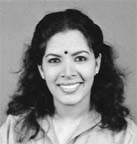 Ramaa Bharadvaj, the Director of Angahara Ensemble in California, is a dancer, teacher, choreographer and actress with over 3 decades of creative achievements. She is the winner of the prestigious Lester Horton Dance Award in Los Angeles and her performances have been listed by Orange County Register, as one of the Most Memorable World Dance events of 1992, 1997 and 2000. A tireless advocate of multicultural education she has taught at various universities and colleges and has reached thousands of inner city children through her outreach presentations. She is the recipient of the Multi Cultural Grant (1995-2001) and Traditional/Folk Arts Grant (1999) from the California Arts Council and has served on dance panels for the CAC and NEA. She is currently on the dance faculty at Orange Coast College in Costa Mesa CA. Ramaa and her daughter Swetha were featured on the cover of the June 2000 issue of Dance Magazine, the world's most prestigious dance publication.
Ramaa Bharadvaj, the Director of Angahara Ensemble in California, is a dancer, teacher, choreographer and actress with over 3 decades of creative achievements. She is the winner of the prestigious Lester Horton Dance Award in Los Angeles and her performances have been listed by Orange County Register, as one of the Most Memorable World Dance events of 1992, 1997 and 2000. A tireless advocate of multicultural education she has taught at various universities and colleges and has reached thousands of inner city children through her outreach presentations. She is the recipient of the Multi Cultural Grant (1995-2001) and Traditional/Folk Arts Grant (1999) from the California Arts Council and has served on dance panels for the CAC and NEA. She is currently on the dance faculty at Orange Coast College in Costa Mesa CA. Ramaa and her daughter Swetha were featured on the cover of the June 2000 issue of Dance Magazine, the world's most prestigious dance publication.
30-Dec-2001
More by : Raama Bharadvaj